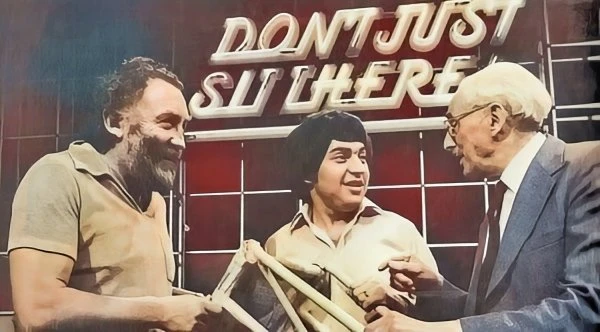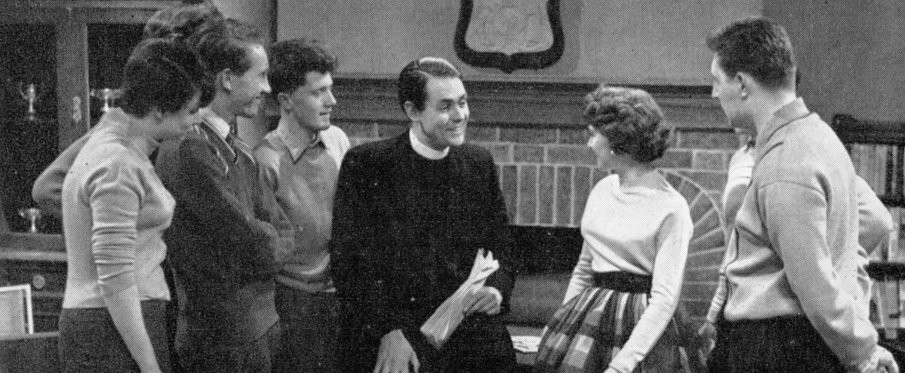
Don't Ask Me
1974 - United KingdomDo giraffes suffer from high blood pressure since they have to pump blood all the way up to their heads? Why do golf balls have dimples? Why doesn't non-drip paint drip? Why do bats hang upside down? You'd be forgiven for thinking that these questions had been posed on the popular children's series How! with either Fred Dinenage or Jack Hargreaves at the ready to not only give you an answer but demonstrate how it works. But no. Considering that How! had been entertaining kids, as well as their parents, since 1966, it was surely logical that an adult version would follow, but it took eight years before one appeared, and when it did it proved to be just as popular as its juvenile predecessor.
Don’t Ask Me was created by Yorkshire Television in 1974 (How! was from Southern) and employed a panel of three experts, each chosen for their colourful and communicative approach to their subjects which tackled viewers' queries, which they were invited to send in, about science and the everyday world.

The regular team of experts was a formidable triumvirate of Doctors Miriam Stoppard, David Bellamy and Magnus Pike who soon found themselves riding high in the Top Twenty of television programmes as recorded by JICTAR (Joint Industry Committee for Television Audience Research).

Medical and anatomical expert Miriam Stoppard (wife of playwright Tom Stoppard) had grown up on a council estate in Newcastle upon Tyne and qualified as a doctor at Newcastle's Royal Infirmary. Don't Ask Me was her television debut. David Bellamy was a botanist, author, and environmental campaigner. He rose to prominence after publishing a paper in the scientific journal Nature, about the Torrey Canyon oil spill in 1967. In 1970, he came to viewers’ attention in the 1973 BBC wildlife series, Life in Our Sea. His distinctive style, his ‘wild man of the woods’ appearance and his much-imitated growly voice made him one of the most recognizable people on television in the 1970s and 1980s as well as a target for mimics. No less a target was Magnus Pike, a nutritional scientist, governmental adviser and writer of Nothing Like Science, who had been broadcasting on BBC radio since 1953 about science and technology. Tall, stooping and white-haired, Pyke was known for his extravagant gesticulations and lively chatter. His arms flailed as he emphasized points or searched for the clearest explanation and his eyes often screwed up in concentration as he engaged with his audience. Pyke was voted the Outstanding New Male Personality of the Year in the 1975 Pye Colour Television Awards.

Derek Griffiths presented the show, making sure that the experts erudite answers to viewers questions didn't go over their heads.
Don’t Ask Me won a special award for the programme producing the biggest reaction from readers in the TV Times Top Ten Awards for 1975 and an influx of new questions. The most popular question appeared to have been, ‘Why is my reflection upside down on one side of a spoon, but the right way up on the other? – sent in by more than a hundred viewers. Other questions often asked were ‘Why is a yawn catching?’ and ‘Why do wheels on stage coaches seem to go backwards in films and on television?’
The huge success of the series meant that budget increases from season three involved more spectacular explanations and the use of outside locations. Blowing up a factory chimney in Bradford was recorded to explain why a chimney breaks its back as it falls and for one programme the whole team went off for the day to Scarborough to record questions and answers from the beach. Later programmes were filmed in locations ranging from a fairground to a sweet factory. But the studio wasn’t forgotten, and members of the public were invited to watch the recordings. The shows’ success was attributed to the fact that a demonstration performed in the studio before a live audience made better television. As a result, Studio 3 at Yorkshire Television’s main Leeds studio accommodated a succession of extraordinary events and objects, including more than eighty different kinds of insects and animals from fleas to elephants.

Some presenter and expert changes were made over the years. Mirriam Stoppard left after series three to be replaced at the start of series four by Dr Robert Buckman, a graduate from St. John's College, Cambridge. He would later join Stoppard for the medical series Where There's Life. He also turned comedian and author and was a familiar voice on BBC Radio 4 during the 1970s and 1980s on panel shows and fronting one-off programmes on scientific topics. He also contributed scripts to the sitcom Doctor on the Go. Also in series four Zoologist Maggie Makepeace replaced David Bellamy when he left to present a programme on ecology. Makepeace had a number of jobs in scientific research and Wildlife Trusts, the most rewarding of which was a 3-year contract on a Scottish estuary studying the social behaviour of shelducks. For a brief time in the 70s she was a television presenter for Yorkshire TV and London Weekend, and gradually became more interested in the psychology of human behaviour, especially communication.
Actor and writer Brian Glover replaced Derek Griffiths as presenter in the third season and Austin Mitchell took over in the fourth season until the final run of shows in 1978.

Following the cancellation of Don’t Ask Me, YTV produced another scientific programme titled Don’t Just Sit There, which re-united Pyke and Bellingham and added Buckman to the lineup. As the title suggested, the series went out of the way to find people who got up and got on with things – people who had actually put their ideas into practice. Many of the features in the programme were decidedly tongue in cheek, such as watching three apparently sane adults trying to plaster a wall with porridge oats, condensed milk and toothpaste, but even these seemingly eccentric experiments had a fun scientific fact or two to reveal. The facts were factual but never dull. Like Don’t Ask Me, Don’t Just Sit There invited viewers to take part by writing in, only in this case instead of asking questions the channel informed viewers that they could ask the boffins to solve a problem, or show off how they’d ingeniously solved one of their own. ‘If you were never an amateur scientist yourself’, Yorkshire promised, ‘the resident team may turn you into one.’
Seen this show? How do you rate it?
Seen this show? How do you rate it?
Published on July 4th, 2024. Written by Laurence Marcus. Sources - TV Times Magazine 1974 & 1979, The Guide to Independent Television 1974 to 1980. for Television Heaven.










